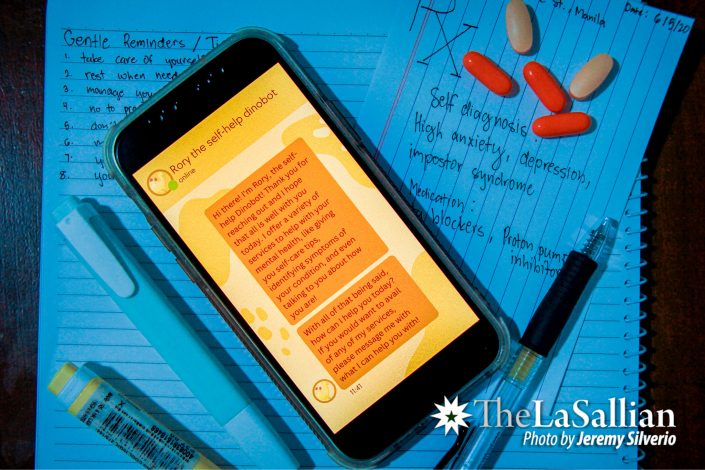Therapy traditionally takes place in a room where two or more individuals engage in introspective conversation. However, the COVID-19 pandemic has upended this practice, prompting some to turn to mobile applications for help.

Apps that use chatbots, mood trackers, and game-based interventions are just some examples of digital therapeutics—a growing field of services that aims to improve one’s mental health through online devices. But what can people expect when their therapist is merely in the palm of their hands?
Barriers to the “psyber” market
Accessibility is perhaps the most significant selling point of mental health apps. Monash University researcher Andrian Liem explains that much of the demand for these technologies—which he dubbed the “psyber market”—stems from their ability to transcend place, time, and language.
Through apps, people can manage their mental health on their own terms and avoid daily inconveniences like traffic and scheduling appointments. In the Philippines, where mental health facilities and professionals are largely situated in the National Capital Region, this is a desirable quality.
Geographic distribution is not the only way in-person therapy fails to support those in need of care. Some treatments may also be hard to obtain without health insurance, leading these obstacles to disproportionately affect those who are low-income, disabled, and members of the LGBTQ+ community. In contrast, many mental health apps are free to download.
While it is ideal to praise these apps for seemingly curbing health disparities, Liem points out that they are not as accessible as one may think. Not everyone can experience these services due to a lack of internet access, electricity, and availability of devices—which are considered necessities to some Filipinos but luxuries to most.
Your phone will see you now
According to the American Psychological Association, there are up to 20,000 mental health apps on the Apple and Android operating systems. For clinical psychologist Sandra Bucci, choosing the right app is akin to dating: the patient encounters an array of digital wellness tools, each with varying perks and costs, but a satisfying relationship is hardly guaranteed.
Based on her research, she believes that the most effective apps are those that closely simulate the in-person experience. Examples include KonsultaMD, BetterHelp, and TalkSpace, which allow clients to text and schedule live video calls with medical workers. They are also the least scalable because they cannot meet the demand for cost-effective mental health services; one session with a psychologist at KonsultaMD is worth P399.
Aside from video calls, text messaging is another common feature in digital therapeutics because it appeals to many people. The privacy-starved can share their thoughts without anyone overhearing, the socially anxious can communicate without facing a stranger, and the people new to therapy can try it without much pressure involved.
For psychologists like Bucci, who are used to in-the-moment conversations, this method is not always effective. “It’s hard to navigate a conversation via text since clients could pick and choose what they respond to,” she stresses.
Meanwhile, other mental health apps rely on algorithms instead of licensed professionals to deliver their services. When designed properly, these technologies can improve their users’ well-being through exercises that follow valid therapeutic models. Some examples of effective algorithm-based apps include Happify, Calm, and Headspace, all of which aim to help patients recognize and cope with negative thoughts and behavior patterns.
Despite the lack of human connection, these apps boast a high user engagement thanks to gamification—the use of game mechanics like badges and leaderboards in non-game environments. Famous apps like Duolingo and Elevate also benefit from gamification as their users are discouraged from breaking their daily streak. In the case of therapy apps, it is used to reinforce healthy behaviors through consistency.
Unregulated technology
Not all apps, however, are created with evidence-based practices. One review involving 52 anti-anxiety apps found that 67 percent of them had been developed without any guidance from a mental health professional. Another study found an app aimed to help those with bipolar disorder that advised users experiencing a manic episode to “take a shot of hard liquor” to help them fall asleep.
Bucci suggests that the sheer number of applications, combined with the limited capacity of regulatory agencies, has made it easy for app developers to make unsubstantiated claims. Moreover, the research on these apps has often been led by the developers themselves. With so little independent research supporting these products, questions of bias and conflict of interest may arise.
The Philippines faces a similar issue regarding indexing and vetting mental health apps. Organizations like the National Telehealth Center have been championing such a law for years. Some proposals in Congress include the Philippine eHealth Systems and Services Act of 2016 and the Telehealth Act of 2014. Unfortunately, these bills have been left to gather dust.
The lack of regulation proves to be concerning as it increases the risk of misrepresenting mental illnesses. It is also indicative of how the government refuses to prioritize affordable health programs, despite the 3.6 million Filipinos diagnosed with a mental health condition.
Future framework
The pandemic has been a potent reminder of what exactly technology can and cannot replace. As it stands, most mental health apps lack peer-reviewed research to support their claims—despite holding value for some people. Ultimately, the best form of therapy will depend on what the individual hopes to achieve, what level of support they need, and what their present circumstances are.
Instead of pitting the two against each other, Bucci recommends exploring how technology can be used to enhance in-person therapy. Digital therapeutics, alongside other telemedicine initiatives, can expand the reach of the healthcare system. Mobile applications, in particular, can offer unique solutions for the self-management of various mental disorders.
To fully unlock this potential, government agencies, corporations, and health advocates need to take accountability for these programs. In advancing the state of mental health care in the country, the dawn of these promising opportunities must be held close by trailblazers who can give Filipinos the quality of life they deserve—in the most accessible way.
